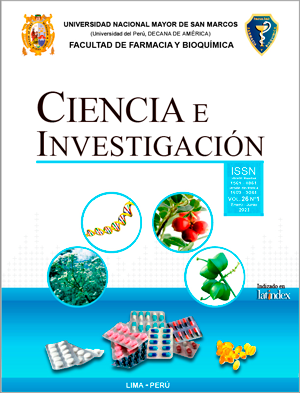Serum levels of apolipoproteins AII and CIII in overweight and obese individuals from Cercado de Lima
DOI:
https://doi.org/10.15381/ci.v26i1.27489Keywords:
Dyslipidemia, Apo AII, Apo CIII, obesity and overweightAbstract
Overweight and obesity are global public health problems that lead to a scenario of alterations in the concentration of circulating lipoproteins; in this scenario, the least studied apoAII and apoCIII have potential as predictors of stroke. The aim of the present study was to determine the levels of apolipoproteins (apoAII and apoCIII) under conditions of overweight and obesity. For this purpose, blood samples were taken from 72 volunteers of both sexes with an age range between 24 and 64 years who were overweight or obese with a body mass index (BMI) greater than 25 kg/m2; additionally, lipid profile, glucose, serum levels of apoAII, apoCIII, insulin, and glycosylated hemoglobin were determined using specific kits following the manufacturer’s instructions. As a result, the average age was 47.3 years, 44.44% were obese, 34.72% were overweight and 20.83% had a normal BMI, with p=0.117, also, statistical differences were observed between groups with respect to glycosylated hemoglobin of 5.72 ± 1.02 % (p<0.039) and insulin 16.2 ± 10.7 mIU/L (p<0.006); in the group of patients with obesity the mean HDL (43.6 ± 11.6) was lower than the mean of the groups (45.8 ± 13.1) and was related to an elevated mean (2.67 ± 0.62) of apoAII without statistical significance (p=0. 222), in contrast to apoCIII (1.21 ± 1.18b,p=0.028). We conclude that apoAII levels do not show statistically significant variation when comparing groups of overweight and obese patients; however, apoCIII does show variations and/or intergroup differences.
Downloads
Published
Issue
Section
License
Copyright (c) 2023 Luz K. Hernández, Gustavo A. Guerra, Gloria C. Gordillo, Juan M. Parreño, Gabriela N. Solano, Juana M. Flores, Enrique León, Antony B. Campos, Ana P. Guerra

This work is licensed under a Creative Commons Attribution 4.0 International License.
LOS AUTORES RETIENEN SUS DERECHOS:
- Los autores retienen sus derechos de marca y patente, y tambien sobre cualquier proceso o procedimiento descrito en el artículo.
- Los autores retienen el derecho de compartir, copiar, distribuir, ejecutar y comunicar públicamente el articulo publicado en la Revista Ciencia e Investigación (por ejemplo, colocarlo en un repositorio institucional o publicarlo en un libro), con un reconocimiento de su publicación inicial en la Revista Ciencia e Investigación.
- Los autores retienen el derecho a hacer una posterior publicación de su trabajo, de utilizar el artículo o cualquier parte de aquel (por ejemplo: una compilación de sus trabajos, notas para conferencias, tesis, o para un libro), siempre que indiquen la fuente de publicación (autores del trabajo, revista, volumen, numero y fecha).













